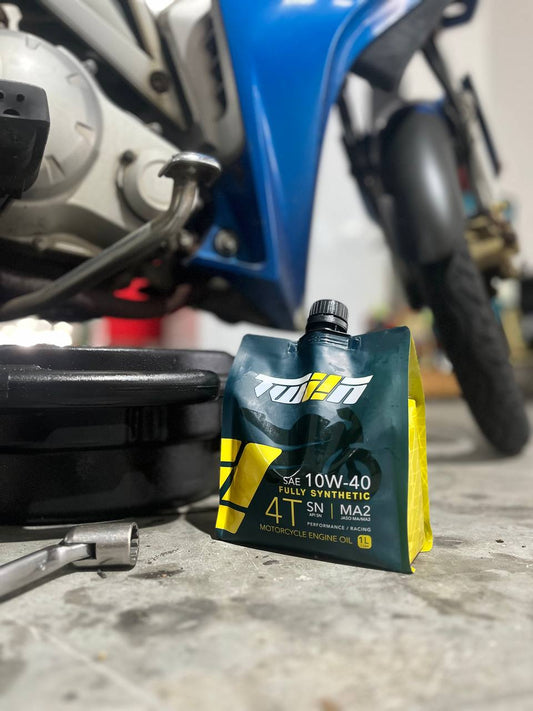Which Engine Oil is right for my Motorcycle?

The best way to answer this question will be for you to refer to your owner’s manual that comes with your motorcycle. After all, the engine oil is designed to meet the engine and not the other way round.
More discerning riders, may deviate or improve on the base requirements found in the manual. This may depend on their riding style, frequency of use, and/or the environment to name a few.
In this section we will discuss in some details terminologies such as:
- SAE Viscosity
- API Gasoline / Petrol Engine Service Classifications
- JASO MA and JASO MB Classifications
- Gear Oil
We’ll be focusing the discussion here on the lubricant’s primary function which is to lubricate and reduce friction. This is usually achieved by the an oil film between the moving parts and it’s ability to transmit load. In engineering terms, we look at the viscosity or the “thickness” of the oil. Viscosity usually decreases with increasing temperature which complicates the use in vehicles as this property will be different at startup and when the vehicle has reached it’s operating temperature. The usual measure of viscosity is Centistoke (cSt) which is translate to mm2/s.
SAE Viscosity
Viscosity grades are either classified as monograde (i.e. SAE 40), where only 1 viscosity measure is defined, or multigrade (i.e. 10W-40), where you have 2 viscosity grade defined. The simple difference of the two types are that monograde only offers protection at operating temperature only, whereas multigrade provides additional protection during startup (hence the additional viscosity with the letter “W”. The other viscosity grade is equivalent to that represented for monograde and is based on operating temperature (generally 100 degrees Celcius). In almost all cases, our machines will require a multigrade oil.
| SAE | Low Temp. Viscosities | High Temp. Viscosities | |||
| Viscosity Grade | Cranking (mPa/s) | Pumping (mPa/s) | Kinematic (cSt) @ 100°C | High Shear Rate (mPa/s) @ 150°C | |
| max | max | min | max | min | |
| 0W | 6,200 @ -35°C | 60,000 @ -40 °C | 3.8 | - | - |
| 5W | 6,600 @ -30°C | 60,000 @ -35°C | 3.8 | - | - |
| 10W | 7,000 @ -25°C | 60,000 @ -30°C | 4.1 | - | - |
| 15W | 7,000 @ -20°C | 60,000 @ -25°C | 5.6 | - | - |
| 20W | 9,500 @ -15°C | 60,000 @ -20°C | 5.6 | - | - |
| 25W | 13,000 @ -10°C | 60,000 @ -15°C | 9.3 | - | - |
| 20 | - | - | 5.6 | <9.3 | 2.6 |
| 30 | - | - | 9.3 | <12.5 | 2.9 |
| 40* | - | - | 12.5 | <16.3 | 2.9 |
| 40** | - | - | 12.5 | <16.3 | 3.7 |
| 50 | - | - | 16.3 | <21.9 | 3.7 |
| 60 | - | - | 21.9 | <26.1 | 3.7 |
SAE J300 0 Automotive Engine Oil Classifications
*for 0W-40, 5W-40 & 10W-40
**for 15W-40, 20W-40 & 25W-40
The low temperature properties (cranking and pumping) relates to cold starts where the lubricant is needed to be pumped within the crankcase and also provide the necessary protection at the right viscosity. Do note that a 10W oil will need to fail the 5W requirement. Hence, using a 5W-30 when a 10W-30 is required is not recommended as despite the lubricant’s ability to flow, there will be limited protection afforded to the moving parts.
API Gasoline / Petrol Engine Service Classifications (4T only)
API is a US based trade association for the oil and gas industry, and it has set up technical standards for the energy conservation of the motor oil. There are 2 general categories, “S” for Spark Ignition (or Petrol Engine) or “C” for Compression Ignition. Each letter is followed by another letter for the most recent standard. I.e currently API SN is the latest petrol engine standard and it was preceded by SM, SL and so forth. Do note that in most cases, the standard is backward compatible, so you can use SP rated oil for an older engine, but not vice versa. There is however a limit, but safe to saw SP can be used for engines manufactured as far back as 1996.
| Category | Status | Service |
| SP | Current |
|
| SN | Current |
For 2020 and older automotive engines |
| SM | Current | For 2010 and older automotive engines |
| SL | Current | For 2004 and older automotive engines |
| SJ | Current | For 2001 and older automotive engines |
| SH | Obsolete | Not suitable for use in automotive engines built after 1996. |
| SG | Obsolete | Not suitable for use in automotive engines built after 1993. |
| SF | Obsolete | Not suitable for use in automotive engines built after 1988. |
| SE | Obsolete | Not suitable for use in automotive engines built after 1979. |
| SD | Obsolete | Not suitable for use in automotive engines built after 1971. |
| SC | Obsolete | Not suitable for use in automotive engines built after 1967. |
| SB | Obsolete | Not suitable for use in automotive engines built after 1951. |
| SA | Obsolete | Contains no additives. Not suitable for engines built after 1930. |
JASO MA and JASO MB Classifications (4T only)
Prior to 1998, car engine oils were used in motorcycles. However, as car technology improves, the use of friction modifiers added into these oils made it unsuitable for motorcycle clutch and gearboxes. New standard developed by Japanese Automotive Association (JASO) were adopted by the motorcycle manufacturers. JASO T 903:2006 can be split into
- JASO MA - for single unit engines where the wet clutch, gearbox and engine use the same oil. They do not contain any friction modifiers. JASO MA is further split into:
- JASO MA1 - regular standard for motorcycles.
- JASO MA2 - higher standard for motorcycles that have a catalytic converters in the exhaust systems.
- JASO MB - This is a lower standard specification for scooters.
- Dynamic Friction Characteristic Index (DFI) - Measure of clutch feel and how progressively power transfers during clutch engagement.
- Static Friction Characteristic Index (SFI) - Measure of closed clutch pack torque handling capacity, resistance to clutch slip under high torque “break-away” conditions.
- Stop Time Index (STI) - Measure of how quickly the clutch engages.
| JASO MA | JASO MB | ||
| JASO MA1 | JASO MA2 | ||
| DFI | ≥1.45 and <1.8 | ≥1.8 and <2.5 | ≥0.5 and <1.45 |
| SFI | ≥1.15 and <1.7 | ≥1.7 and <2.5 | ≥0.5 and <1.15 |
| STI | ≥1.55 and <1.9 | ≥1.9 and <2.5 | ≥0.5 and <1.55 |
For the 3 properties, if an engine oil meets all specs under JASO MA1, then it will be considered as such and likewise for JASO MA2. However, if there is a mix in specification between MA1 and MA2, then the oil will be considered JASO MA.
Gear Oil
Most modern motorcycles use the same oil for the engine and gear box. However, some BMWs and Harleys have a separate gearbox to the engine and require a separate gear oil. So do all 2-stroke motorcycles and scooters.
Engine oils and gear oils are very different. Where engine oils are used to reduce friction, maintain pH (due to fuels) and cool the engine, gear oils on the other hand are designed to withstand pressure and heat from the gears. They also have anti wear particles to prolong the lift and to protect the components in the gearbox. Simply put, gear oil don’t withstand the heat of the engine and engine oil cannot withstand the extreme pressures of the gears.
TLDR; Always check the owner’s manual to see which specification is required. if both API and JASO MA specifications are listed, make sure you pick an oil that qualifies for both specifications.
Note: We have skipped 2T engine oil in this section and will cover it in a separate post.
Definition:
- SAE - Society of Automotive Engineers
- API - American Petroleum Institute
- JASO - Japanese Automotive Standards Organization



